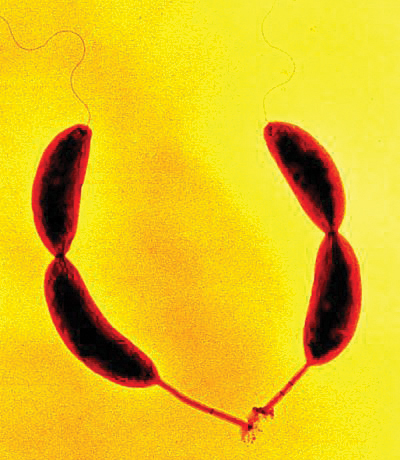Bacterial sphingolipids: Perhaps not as rare as we thought?
Among the ways cells adapt to changes in their environment, regulation of the lipidome is critical for maintaining cellular integrity. Species that lack temperature homeostasis adapt by modulating acyl chain saturation to resist changes in membrane fluidity. Bacteria such as Escherichia coli desaturate their fatty acids as temperatures decrease; the double bonds formed by acyl chain desaturation introduce kinks in the fatty acids that inhibit lipid packing and increase membrane fluidity to counteract the effects of lower temperature.
 Eric Klein’s lab showed that the Gram-negative aquatic bacterium Caulobacter crescentus synthesizes a novel glycosphingolipid when phosphates in its environment are limited.U.S. Department of Energy/Wikimedia Commons
Eric Klein’s lab showed that the Gram-negative aquatic bacterium Caulobacter crescentus synthesizes a novel glycosphingolipid when phosphates in its environment are limited.U.S. Department of Energy/Wikimedia Commons
Temperature is not the only environmental variable that necessitates membrane remodeling. In many settings, nutrient availability can vary widely. For example, nutrient levels in fresh-water lakes fluctuate with the seasons, and plant decomposition affects soil. In particular, oscillations in phosphate concentration can limit bacterial growth.
When phosphates are limited, the synthesis of membrane phospholipids becomes an obvious challenge. Studies have shown that alphaproteobacteria, such as Agrobacterium tumefaciens and Mesorhizobium loti, adapt to phosphate starvation by increasing production of diacylglycerol-based glyceroglycolipids and ornithine lipids.
In our lab, we recently showed that the Gram-negative aquatic bacterium Caulobacter crescentus responds to phosphate limitation by synthesizing a novel hexosyl-hexuronosyl-ceramide glycosphingolipid, or GSL. Ceramide-based GSLs are ubiquitous in eukaryotic organisms, but in bacteria they had been observed previously only in the Sphingomonadaceae family, where they function as a substitute for outer-membrane lipopolysaccharides, or LPS. Unlike Sphingomonas species, C. crescentus produces LPS even during phosphate starvation; in this organism, the GSLs appear to play a role in resistance to phage-mediated killing.
Now that we know that bacterial GSLs are not limited to just the Sphingomonadaceae, just how widespread are these lipid species? The honest answer is that we simply don’t know. While the lipidomes of many bacteria have been characterized, our findings in C. crescentus demonstrate that lipid abundance can vary with growth conditions. Indeed, previous characterizations in rich growth media did not identify GSLs in C. crescentus.
Another major challenge is that, unlike for eukaryotes, we do not know which enzymes are responsible for ceramide synthesis in prokaryotes. Only the enzyme that catalyzes the first step of ceramide synthesis, serine palmitoyltransferase, has clear homologues in bacteria as described in a recent review by Dominic Campopiano and colleagues. This implies that either (1) bacteria carry out the same synthetic chemistry as eukaryotes, but these enzymes diverged so long ago that the functionally equivalent proteins cannot be identified by sequence homology or (2) bacterial ceramide synthesis evolved independently using novel enzymes and/or synthetic pathways. If the genes required for ceramide synthesis are identified, researchers will be able to take a bioinformatic approach to finding additional species that might produce these lipids.
A growing body of work demonstrates that bacterially produced sphingolipids may play an important role in aspects of human health such as gut homeostasis and oral pathology. Uncovering the mechanism of prokaryotic ceramide synthesis will help determine how widespread these lipids are in bacteria and also may provide a novel route for pharmacological intervention.
Enjoy reading ASBMB Today?
Become a member to receive the print edition four times a year and the digital edition monthly.
Learn moreGet the latest from ASBMB Today
Enter your email address, and we’ll send you a weekly email with recent articles, interviews and more.
Latest in Science
Science highlights or most popular articles

Fueling healthier aging, connecting metabolism stress and time
Biochemist Melanie McReynolds investigates how metabolism and stress shape the aging process. Her research on NAD+, a molecule central to cellular energy, reveals how maintaining its balance could promote healthier, longer lives.

Mapping proteins, one side chain at a time
Roland Dunbrack Jr. will receive the ASBMB DeLano Award for Computational Biosciences at the ASBMB Annual Meeting, March 7–10, just outside of Washington, D.C.

Exploring the link between lipids and longevity
Meng Wang will present her work on metabolism and aging at the ASBMB Annual Meeting, March 7-10, just outside of Washington, D.C.

Defining a ‘crucial gatekeeper’ of lipid metabolism
George Carman receives the Herbert Tabor Research Award at the ASBMB Annual Meeting, March 7–10, just outside of Washington, D.C.

The science of staying strong
Muscles power every movement, but they also tell the story of aging itself. Scientists are uncovering how strength fades, why some species resist it and what lifestyle and molecular clues could help preserve muscle health for life.

Bacteriophage protein could make queso fresco safer
Researchers characterized the structure and function of PlyP100, a bacteriophage protein that shows promise as a food-safe antimicrobial for preventing Listeria monocytogenes growth in fresh cheeses.

